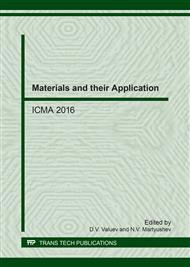[1]
D. Croccolo, Adhesives: Mechanical properties, technologies and economic importance, New York, Nova Science Publishers Inc, (2014).
Google Scholar
[2]
W.A. Lees, Adhesives in engineering design. Berlin, Springer Science & Business Media, (2013).
Google Scholar
[3]
J.R. Weitzenböck, Adhesives in Marine Engineering. Oxford–New Delhi, Woodhead Publishing Limited, (2012).
Google Scholar
[4]
A. Scattina, D. Roncato, G. Belingardi, G. Martino, Investigation of creep phenomenon on composite material for bolt connections, Composite Structures, 134 (2015) 378–383.
DOI: 10.1016/j.compstruct.2015.08.061
Google Scholar
[5]
X.X. Fu, Y.Q. Wang, The Elastohydrodynamic Lubrication Analysis of Composite Material Gear, Advanced Materials Research, 706-708 (2013) 1622–1626.
DOI: 10.4028/www.scientific.net/amr.706-708.1622
Google Scholar
[6]
C.Y. Son, H.I. Byun, K.H. Kim, J.K. Choi, J.Y. Shin, An Analysis and Experimental Study of the Rotor Blade with Composite Material Fiber Reinforced Plastics, Key Engineering Materials, 306-308 (2006) 851–856.
DOI: 10.4028/www.scientific.net/kem.306-308.851
Google Scholar
[7]
M.D.M. Gift, J. Selvakumar, S.J. Alexis, Fracture studies of an adhesive joint involving composition alteration, Journal of Chemical and Pharmaceutical Sciences, 2015-April (2015), 269–273.
Google Scholar
[8]
H. Chai, J. Fox, On delamination growth from channel cracks in thin-film coatings, International Journal of Solids and Structures, 49 Issue 22 (2012), 3142–3147.
DOI: 10.1016/j.ijsolstr.2012.06.012
Google Scholar
[9]
G. Meneghetti, M. Quaresimin, M. Ricotta, Damage mechanisms in composite bonded joints under fatigue loading, Composites Part B: Engineering, 43 Issue 2 (2012) 210–220.
DOI: 10.1016/j.compositesb.2011.07.009
Google Scholar
[10]
G. Rauchs, P.J. Withers, Computational assessment of the influence of load ratio on fatigue crack growth in fibre-reinforced metal matrix composites, International Journal of Fatigue, 24 (2002) 1205–1211.
DOI: 10.1016/s0142-1123(02)00047-6
Google Scholar
[11]
P. Harnatkiewicz, A. Kopczyński, M. Kożuch, W. Lorenc, S. Rowiński, Research on fatigue cracks in composite dowel shear connection, Engineering Failure Analysis, 18 (2011) 1279–1294.
DOI: 10.1016/j.engfailanal.2011.03.016
Google Scholar
[12]
S. Nojavan, D. Schesser, Q.D. Yang, A two-dimensional in situ fatigue cohesive zone model for crack propagation in composites under cyclic loading, International Journal of Fatigue, 82 Issue 2 (2016) 449–461.
DOI: 10.1016/j.ijfatigue.2015.08.029
Google Scholar
[13]
S.H. Ju, S.H. Liu, Determining stress intensity factors of composites using crack opening displacement, Composite Structures, 81 Issue 2 (2007) 614–621.
DOI: 10.1016/j.compstruct.2006.11.002
Google Scholar
[14]
A. Bernasconi, A. Jamil, F. Moroni, A. Pirondi, A study on fatigue crack propagation in thick composite adhesively bonded joints, International Journal of Fatigue, 50 (2013) 18–25.
DOI: 10.1016/j.ijfatigue.2012.05.018
Google Scholar
[15]
N. Fantuzzi, R. Dimitri, F. Tornabene, A SFEM-based evaluation of mode-I stress Intensity factor in composite structures, Composite Structures, 145 (2016) 162–185.
DOI: 10.1016/j.compstruct.2016.02.076
Google Scholar
[16]
E.M. Craciun, Energy criteria for crack propagation in pre-stressed elastic composites, Solid Mechanics and its Applications, 154 (2008) 193–237.
DOI: 10.1007/978-1-4020-8772-1_7
Google Scholar
[17]
N. Muthu, S.K. Maiti, B.G. Falzon, W. Yan, Crack propagation in non-homogenous materials: Evaluation of mixed-mode SIFs, T-stress and kinking angle using a variant of EFG Method, Engineering Analysis with Boundary ElementsVolume, 72 (2016) 11–26.
DOI: 10.1016/j.enganabound.2016.07.017
Google Scholar
[18]
M. Fakoor, S.M.N. Ghoreishi, N.M. Khansari, Investigation of composite coating effectiveness on stress intensity factors of cracked composite pressure vessels, Journal of Mechanical Science and Technology, 30 Issue 7 (2016) 3119–3126.
DOI: 10.1007/s12206-016-0621-8
Google Scholar
[19]
M. Fan, D.K. Yi, Z.M. Xiao, Elastic-plastic stress investigation for an arc-shaped interface crack in composite material, International Journal of Mechanical Sciences, 83 (2014) 104–111.
DOI: 10.1016/j.ijmecsci.2014.03.034
Google Scholar


